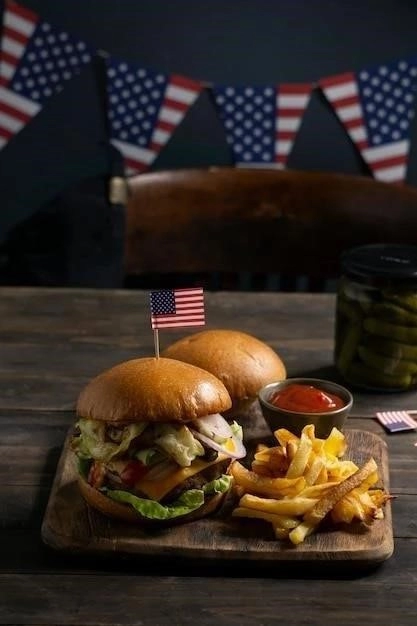American Food: A Fusion of Flavors
American cuisine is renowned for its diverse and eclectic nature, a testament to the nation’s rich history as a melting pot of cultures. From the indigenous ingredients of Native Americans to the culinary traditions brought by waves of immigrants, American food represents a fascinating fusion of flavors and influences.
1. The Melting Pot: A History of Culinary Influences
The narrative of American cuisine is deeply intertwined with the nation’s history of immigration. From the first interactions with Native Americans to the successive waves of European settlers, enslaved Africans, and Asian and Latin American immigrants, each group contributed unique ingredients, cooking techniques, and culinary traditions. This amalgamation of influences resulted in a cuisine that is both diverse and constantly evolving.
The arrival of Europeans in the 16th and 17th centuries marked a turning point, introducing ingredients like wheat, beef, and dairy. British and Dutch culinary practices significantly influenced early American cuisine. Later, the influx of German, Irish, and Italian immigrants further diversified the culinary landscape. German immigrants brought their traditions of sausage-making and baking, while the Irish left their mark with potato dishes and stews. Italian immigrants introduced pasta, pizza, and a love for fresh produce.
Beyond Europe, Asian and Latin American flavors have become integral components of American cuisine. Chinese immigrants, arriving in the 19th century, established a distinct Chinese-American culinary tradition, with dishes like chop suey and fortune cookies becoming staples. Mexican immigrants, particularly in the Southern and Southwestern states, introduced chili peppers, corn tortillas, and a vibrant array of spices that have profoundly impacted American palates.
2. Native American Roots: The Foundation of American Cuisine
While American cuisine is often associated with the influences of later immigrants, it’s crucial to recognize the foundational role of Native American culinary traditions. Long before the arrival of Europeans, indigenous communities across the continent cultivated a diverse range of ingredients and developed unique cooking methods that continue to influence American foodways today.
The “Three Sisters” — corn, beans, and squash — formed the cornerstone of many Native American diets and remain staples in American cuisine. These crops were often grown together, with the cornstalk providing support for the beans and the squash vines acting as a natural ground cover. Native Americans also cultivated a variety of other vegetables, including potatoes, tomatoes, and peppers, which would later become central to global cuisines.
Beyond agriculture, indigenous communities utilized hunting, fishing, and gathering practices to supplement their diets. Wild game, such as deer, turkey, and bison, provided protein, while fish and shellfish were integral to coastal and riverine communities. Native Americans also possessed extensive knowledge of wild plants, using them for food, medicine, and flavoring agents. These ingredients and techniques continue to influence modern American chefs, who are increasingly incorporating indigenous foods and culinary wisdom into their dishes.
3. European Influences: From Colonial Times to the Present
European culinary traditions have left an indelible mark on American cuisine, shaping its development from the colonial era to the present day. The arrival of European settlers brought a wave of new ingredients, cooking techniques, and culinary customs that blended with existing Native American foodways, laying the foundation for what would become a distinctly American culinary identity.
British culinary practices exerted a particularly strong influence in the early colonies. Dishes like roast beef, Yorkshire pudding, and various pies became staples, reflecting a hearty and savory approach to cooking. The Dutch, too, left their culinary imprint, introducing ingredients like coleslaw and cookies, which have since become deeply ingrained in American food culture.

Subsequent waves of European immigration further diversified the American culinary landscape. The arrival of German immigrants in the 18th and 19th centuries brought traditions of sausage-making, baking, and beer brewing. Similarly, Italian immigrants, arriving in large numbers in the late 19th and early 20th centuries, introduced pasta, pizza, and a love for fresh, flavorful ingredients. These diverse European influences continue to shape American cuisine, from classic comfort foods to innovative fine dining experiences.
4. African American Contributions: The Soul of Southern Cooking
African American culinary traditions are deeply woven into the fabric of American cuisine, particularly in the South, where enslaved Africans played a pivotal role in shaping the region’s culinary identity. Despite enduring unimaginable hardships, enslaved individuals brought with them agricultural knowledge, cooking techniques, and flavor palettes that continue to enrich and define Southern cooking.

Forced to work on plantations, enslaved Africans brought their expertise in rice cultivation, a skill that proved invaluable in the American South’s humid climate. They also incorporated ingredients like okra, black-eyed peas, and watermelon, foods often overlooked or dismissed by European colonists, into their dishes. These ingredients, now celebrated as quintessential Southern staples, are a testament to the ingenuity and resilience of enslaved African cooks.
Beyond specific ingredients, African American cooking traditions emphasize slow cooking methods, rich flavors, and a deep connection to the land. Dishes like gumbo, jambalaya, and shrimp and grits exemplify the fusion of West African, Caribbean, and European influences that characterize Southern cuisine. These dishes are more than just food; they represent a rich cultural heritage passed down through generations.

5. Asian and Latin American Flavors: Adding Spice and Diversity
American cuisine’s remarkable diversity is further enriched by the significant contributions of Asian and Latin American culinary traditions. Through waves of immigration and cultural exchange, these vibrant culinary cultures have become deeply integrated into the American palate, adding layers of flavor, spice, and global influence.
The influx of Chinese immigrants in the 19th century introduced new flavors and cooking techniques to American shores. Initially concentrated in Western states, Chinese cuisine rapidly gained popularity, adapting to American tastes and ingredients. Dishes like chop suey and fortune cookies, while not necessarily authentically Chinese, represent the early fusion of Chinese and American culinary traditions. Today, from Sichuan hot pot to Vietnamese pho, authentic Asian cuisines are embraced across the United States.

Latin American culinary influences are equally pervasive, particularly in the Southern and Southwestern regions. Mexican cuisine, with its emphasis on bold flavors, fresh ingredients, and spicy chilies, has become a cornerstone of American food culture. Dishes like tacos, burritos, and enchiladas are ubiquitous, while regional variations, such as Tex-Mex and New Mexican cuisine, showcase the dynamic evolution of these culinary traditions.
6. Regional Specialties: A Culinary Journey Across America

Exploring the diverse regional specialties of American cuisine is akin to embarking on a captivating culinary journey across the vast and varied landscape of the United States. Each region boasts its own unique culinary identity, shaped by local ingredients, cultural heritage, and historical influences.

New England, with its long coastline, is renowned for its fresh seafood, showcased in dishes like clam chowder, lobster rolls, and baked beans. The Mid-Atlantic region features hearty fare influenced by early Dutch and German settlers, evident in dishes like Philly cheesesteaks, crab cakes, and shoofly pie. The South, with its rich culinary traditions, tantalizes with soul food staples like fried chicken, collard greens, and shrimp and grits.
Moving westward, the Southwestern states offer a vibrant tapestry of Mexican-inspired cuisine, with dishes like chili con carne, tacos al pastor, and Navajo frybread. The Pacific Northwest, known for its lush forests and bountiful waters, provides a cornucopia of seafood, wild mushrooms, and fresh produce, reflected in its cuisine. From Dungeness crab to marionberry pie, the region offers a unique culinary experience.
7. The Rise of Fast Food: Convenience and its Consequences
The rise of fast food in the latter half of the 20th century marked a profound shift in American dining habits, inextricably linking convenience with culinary choices. Driven by factors such as increased mobility, changing work patterns, and the allure of affordability, fast food restaurants proliferated across the nation, offering readily available meals that catered to a fast-paced lifestyle.
The standardization and mass production inherent in the fast food model led to a decline in the consumption of fresh, home-cooked meals, with processed ingredients and pre-prepared foods becoming increasingly prevalent in American diets. This shift coincided with a rise in health concerns, such as obesity and heart disease, as the high calorie, high-fat content of many fast food options raised alarms about nutritional imbalances.
While the convenience of fast food remains undeniable, its impact on American health and culinary traditions has been a subject of ongoing debate. The proliferation of fast food chains, often at the expense of local eateries, raised concerns about homogenization and the potential erosion of regional culinary diversity. Moreover, the environmental impact of fast food, from packaging waste to the industrialization of food production, has fueled calls for more sustainable and health-conscious dining choices.
8. The Farm-to-Table Movement: A Return to Freshness and Flavor
In response to the perceived homogenization and health concerns associated with industrialized food production, the farm-to-table movement emerged as a culinary and cultural counterpoint, emphasizing fresh, locally sourced ingredients and a renewed appreciation for seasonality and regional flavors.
At the heart of the farm-to-table philosophy lies a commitment to sourcing ingredients directly from local farmers, ranchers, and fishermen, fostering a closer connection between consumers and the origins of their food. This emphasis on locality not only supports local economies but also reduces the environmental impact associated with long-distance food transportation. Chefs at farm-to-table establishments often take pride in crafting menus that showcase the season’s bounty, allowing the natural flavors of fresh ingredients to shine.
Beyond its culinary focus, the farm-to-table movement represents a broader cultural shift towards sustainability, transparency, and a renewed appreciation for the artistry of food production. By prioritizing fresh, seasonal ingredients, farm-to-table chefs and consumers alike are reclaiming the connection between food, community, and the natural world. This movement has sparked a national conversation about the importance of supporting local agriculture, reducing our environmental footprint, and savoring the flavors of fresh, thoughtfully prepared meals.
9. American Cuisine Today: A Fusion of Tradition and Innovation
American cuisine today is a vibrant tapestry woven from the threads of its rich culinary heritage and the dynamic forces of innovation and globalization. It represents a dynamic interplay between tradition and experimentation, where time-honored recipes are reimagined with modern techniques and global flavors seamlessly intertwine with regional specialties.
Chefs across the United States are drawing inspiration from the diverse cultural influences that have shaped American foodways, revisiting classic dishes with a contemporary sensibility. Southern comfort food, for instance, is experiencing a renaissance, with chefs elevating traditional recipes with locally sourced ingredients and innovative preparations. Similarly, immigrant cuisines, once relegated to ethnic enclaves, are now embraced by mainstream dining culture, their bold flavors and unique ingredients influencing a new generation of American chefs.
This culinary dynamism is further fueled by a growing awareness of sustainability, health, and ethical sourcing practices. Consumers are increasingly interested in the provenance of their food, seeking out locally sourced ingredients, organic produce, and humanely raised meat. This discerning approach to dining is reflected in the menus of restaurants across the country, where seasonality, freshness, and a commitment to quality are paramount.
10. The Future of American Food: Trends and Predictions
Gazing into the culinary crystal ball, the future of American food promises a captivating fusion of enduring traditions, innovative techniques, and a growing awareness of global interconnectedness. Several key trends are poised to shape the American culinary landscape in the years to come, reflecting evolving consumer preferences, technological advancements, and a deeper understanding of food systems.
Plant-based dining is expected to continue its meteoric rise, driven by concerns for personal health, animal welfare, and the environmental impact of meat consumption. Chefs are embracing creative culinary techniques to transform vegetables, legumes, and plant-based proteins into satisfying and flavorful centerpieces. Moreover, advancements in cellular agriculture, which cultivates meat products directly from animal cells, hold the potential to revolutionize meat consumption, offering a more sustainable and ethical alternative to traditional animal farming.

Technology will continue to play an increasingly influential role in shaping how we experience food. From online grocery delivery services that prioritize local sourcing to artificial intelligence-powered kitchen appliances that simplify home cooking, technology is streamlining access to fresh ingredients and facilitating culinary creativity. As American cuisine continues to evolve, it will undoubtedly reflect the dynamic interplay of tradition, innovation, and a growing awareness of our interconnectedness in a global food system.










